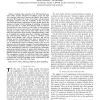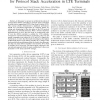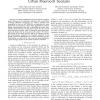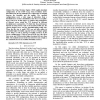VTC
2010
IEEE
13 years 10 months ago
2010
IEEE
Abstract— Mobile radio networks of the IMT-Advanced systems family promise ubiquitous broadband access and high area coverage, with rates of several 100 MBit/s. They claim to gua...
VTC
2010
IEEE
13 years 10 months ago
2010
IEEE
—We present the ǫ-outage capacity in the low signal-to-noise ratio (SNR) regime of an incremental relaying network. The network consists of one source, one destination, and two ...
VTC
2010
IEEE
13 years 10 months ago
2010
IEEE
—In this paper we present an architectural analysis of a smart DMA (sDMA) controller for protocol stack acceleration in mobile devices supporting 3GPP’s Long Term Evolution (LT...
VTC
2010
IEEE
13 years 10 months ago
2010
IEEE
—In this paper, we introduce a collision model for vehicular cluster and we propose path selection algorithms for multi-hop VANETs. That is, we propose the intuitive algorithm na...
VTC
2010
IEEE
13 years 10 months ago
2010
IEEE
VTC
2010
IEEE
13 years 10 months ago
2010
IEEE
—A common simplification in the treatment of random linear channels is the wide-sense stationary and uncorrelated scattering (WSSUS) assumption. For wireless channels, this assu...
VTC
2010
IEEE
13 years 10 months ago
2010
IEEE
—In recent years, the rapid development of wireless communication allows us to enjoy more multimedia services via wireless network. However, due to lack of QoS support and charac...
VTC
2010
IEEE
13 years 10 months ago
2010
IEEE
— In this paper, we propose a downlink power control scheme for a wireless system which utilizes a smart antenna technology for space division multiple access(SDMA). In the wirel...
VTC
2010
IEEE
13 years 10 months ago
2010
IEEE
— A low complexity distributed coding scheme is proposed for communications over Rayleigh fading channels. Convolutional Coding (CC) assisted Differential Phase-Shift Keying (DPS...
VTC
2010
IEEE
13 years 10 months ago
2010
IEEE
The Time Division Duplex (TDD) uplink-downlink configuration of the 3GPP Long Term Evolution (LTE) determines how the ten subframes in a radio frame are divided between the downlin...




